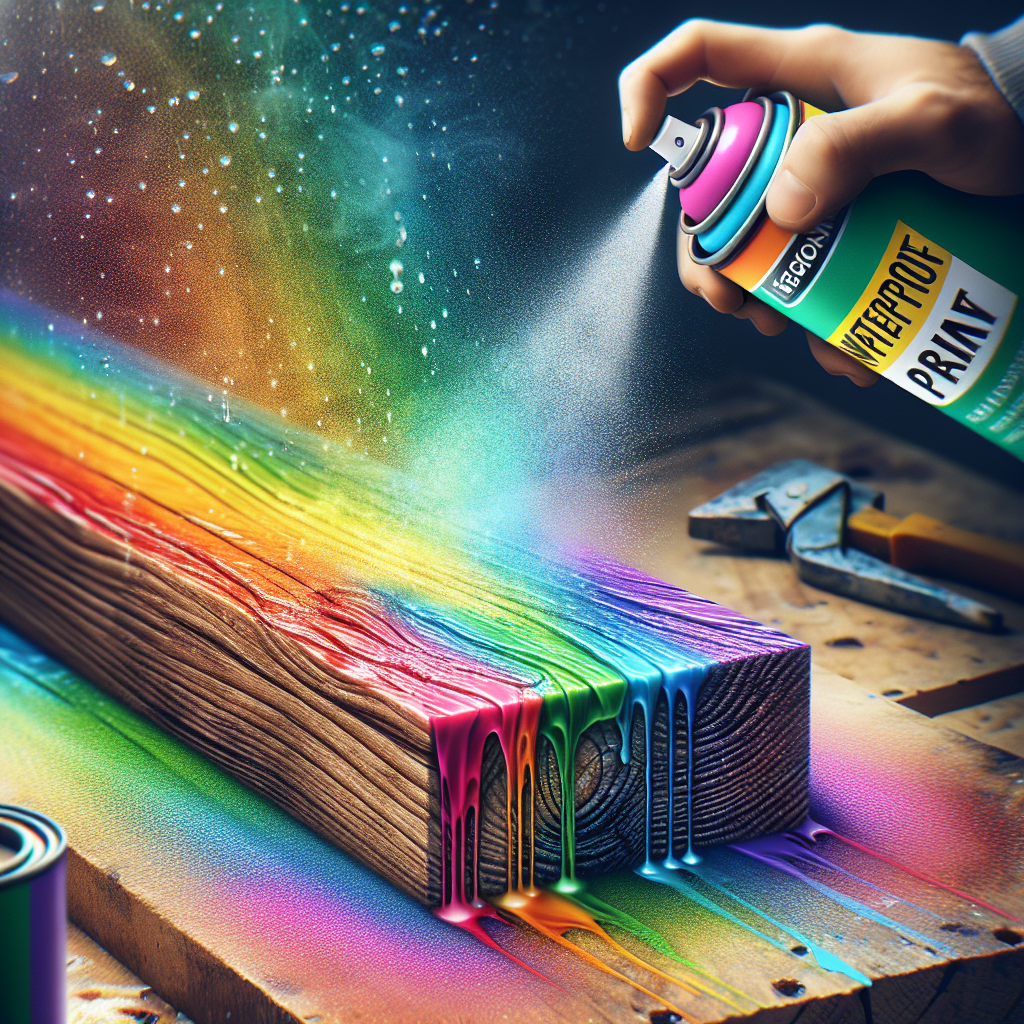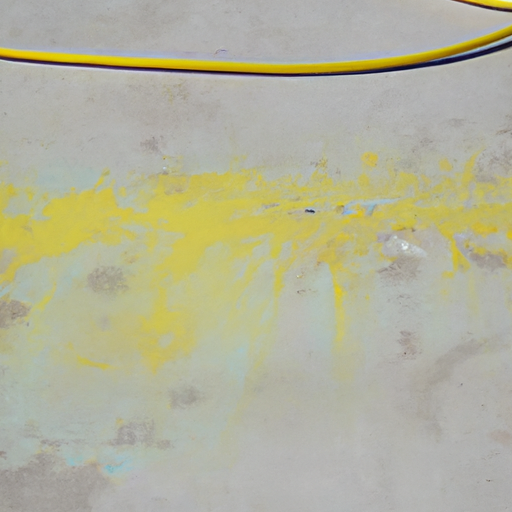Spray painting is a popular method for adding color and enhancing the appearance of various surfaces. However, when it comes to waterproofing wood, many individuals are left wondering if spray paint is a reliable solution. In this article, we will assess the effectiveness of spray paint as a waterproofing agent for wood materials, shedding light on whether it can truly protect and preserve wood surfaces from the damaging effects of moisture. By delving into the properties of spray paint and its interaction with wood, you will gain valuable insights into this common dilemma and make informed decisions when it comes to waterproofing your wooden projects.
Introduction
Spray paint has been a popular choice for many DIY enthusiasts and professionals alike due to its convenience and ease of use. While it is commonly used for refreshing the appearance of various surfaces, it is also often utilized as a means of waterproofing wood. In this article, we will explore the potential benefits and limitations of using spray paint to waterproof wood. Additionally, we will discuss alternative options and important considerations to ensure the best possible outcome for your project.
Understanding Spray Paint
What is spray paint?
Spray paint is a type of paint that is contained in a pressurized canister. It is designed to be applied by pressing down on a nozzle, which releases a fine mist of paint particles. This method allows for quick and efficient coverage, resulting in a smooth and even finish.
How does spray paint work?
Spray paint works by using a combination of solvents, pigments, and propellants. When the nozzle is pressed down, the propellant inside the canister pushes the paint forward, forcing it through the nozzle. The pigments in the paint provide color, while the solvents help to achieve the desired viscosity and drying time.
Types of spray paint
There are various types of spray paint available on the market, each catering to different needs and surfaces. Some common types include acrylic spray paint, enamel spray paint, and latex spray paint. It is important to choose the appropriate type of spray paint for your wood waterproofing project to ensure optimal results.

This image is property of images.unsplash.com.
Properties of Wood
Characteristics of wood
Wood possesses several unique properties that make it an attractive choice for various applications. It is a versatile and durable material that can be shaped and manipulated to suit different needs. Additionally, wood has a natural beauty and warmth that can enhance the aesthetics of any space.
Permeability of wood
One important property of wood is its permeability. Wood has the ability to absorb and release moisture depending on the surrounding humidity levels. This natural characteristic can make wood susceptible to damage and rot if not properly protected.
How wood reacts to moisture
When exposed to moisture, wood can expand and contract, leading to warping, cracking, and decay. This can significantly reduce the lifespan and structural integrity of the wood. Hence, it is crucial to implement measures to protect wood from excessive moisture and ensure its longevity.
Potential Waterproofing Benefits
Protection against moisture
One of the main benefits of using spray paint to waterproof wood is its ability to provide a protective barrier against moisture. Spray paint forms a continuous and uniform layer on the surface of the wood, preventing water from seeping into the fibers. This can help to reduce the risk of rot and other forms of water damage.
Extending wood lifespan
By effectively waterproofing wood with spray paint, you can extend its lifespan and maintain its structural integrity. By preventing moisture from penetrating the wood, you are minimizing the risk of rot, decay, and other forms of deterioration. This can be particularly advantageous for outdoor wooden structures, such as fences, decks, and furniture.
Preventing wood rot
Wood rot is a common issue faced by many homeowners and construction professionals. It occurs when fungi or bacteria break down the wood fibers, resulting in decay. Spray paint can act as a protective barrier, preventing the growth and penetration of these damaging microorganisms, thus reducing the likelihood of wood rot.

This image is property of images.unsplash.com.
Factors to Consider
Type of wood
The type of wood you are working with can greatly impact the effectiveness of spray paint as a waterproofing solution. Some woods have natural oils or resins that can hinder the adhesion of the spray paint. Additionally, certain woods may be more prone to warping or splitting when exposed to moisture. It is essential to choose a spray paint specifically formulated for the type of wood you are working with.
Surface preparation
Proper surface preparation is crucial for the successful application of spray paint. Before applying the paint, the wood surface should be clean, dry, and free from any contaminants such as dirt, dust, or grease. Sanding the surface can also help to improve adhesion and create a smooth finish.
Environmental conditions
The environment in which the wood is located will also influence the effectiveness of the spray paint as a waterproofing solution. For instance, if the wood is constantly exposed to direct sunlight, extreme temperatures, or high humidity levels, it may require a more durable and weather-resistant spray paint.
Quality of spray paint
The quality of the spray paint can significantly impact its waterproofing capabilities and longevity. High-quality spray paints are often formulated with superior binders and resins that provide enhanced protection against moisture. It is advisable to choose a reputable brand and opt for spray paints that are specifically designed for outdoor or waterproofing applications.
Proper Application
Cleaning the wood surface
Before applying spray paint to waterproof wood, it is crucial to thoroughly clean the wood surface. Remove any dirt, debris, or existing paint using a brush or sandpaper. Ensure that the surface is dry and free from any moisture.
Preparing the surface
Once the wood surface is clean, it is essential to prepare it for optimal adhesion of the spray paint. Sanding the surface can help to remove any rough patches or imperfections, creating a smooth canvas for the paint to adhere to. Additionally, consider applying a suitable primer or sealer to further enhance the paint’s bond with the wood.
Choosing the right spray paint
Selecting the appropriate spray paint is vital for achieving the desired waterproofing effect. Consider the type of wood, the environmental conditions, and the level of durability required. Read the product labels carefully and choose a spray paint that is specifically formulated for wood waterproofing applications.
Application techniques
To ensure a professional-looking finish, proper application techniques are crucial. Hold the spray paint can approximately 6-8 inches away from the wood surface and maintain a consistent distance throughout the application process. Apply thin, even coats, allowing each coat to dry before applying the next. Over-applying the spray paint can lead to drips, runs, or uneven coverage.
Multiple coats and drying time
Depending on the desired level of waterproofing, multiple coats of spray paint may be necessary. Allow each coat to dry completely before applying the next. The drying time can vary depending on the type and brand of spray paint used, as well as the environmental conditions. Refer to the manufacturer’s instructions for specific drying time recommendations.

This image is property of images.unsplash.com.
Effectiveness of Spray Paint on Wood
Does spray paint make wood waterproof?
While spray paint can provide a degree of waterproofing to wood, it is important to note that it does not make wood completely waterproof. Wood is a porous material, and spray paint only forms a protective barrier on the surface. It can help to reduce the risk of moisture damage, but it cannot completely eliminate it.
Limitations of spray paint
Spray paint has certain limitations when it comes to waterproofing wood. The effectiveness of the waterproofing can be influenced by factors such as the type of wood, the quality of the spray paint, and the application technique. Additionally, over time, the protective barrier created by the spray paint may degrade or wear off, requiring reapplication.
Duration of waterproofing effect
The duration of the waterproofing effect achieved with spray paint can vary depending on several factors, including the quality of the spray paint, the type of wood, and the exposure to environmental conditions. In general, it is advisable to monitor the wood regularly and be prepared to reapply the spray paint as needed.
Factors affecting effectiveness
Several factors can affect the overall effectiveness of spray paint as a waterproofing solution for wood. These include exposure to extreme weather conditions, UV radiation, the presence of standing water, and the quality and durability of the spray paint itself. Regular inspections and maintenance can help to identify any areas that may require reapplication or additional protection.
Alternatives to Spray Paint
Wood sealers
Wood sealers are specifically designed to penetrate the wood fibers, creating a protective barrier against moisture. They can help to enhance the natural beauty of the wood while providing long-lasting waterproofing properties. Wood sealers come in various formulations, including oil-based, water-based, and hybrid options.
Varnishes
Varnishes are widely used as a protective finish for wood surfaces. They provide a hard, durable coating that can offer excellent resistance to moisture, UV radiation, and wear. Varnishes can be applied using a brush, roller, or spray gun, depending on the desired finish and level of protection.
Polyurethane
Polyurethane is a popular choice for waterproofing wood due to its excellent durability and waterproofing properties. It forms a protective film on the surface of the wood, providing resistance to moisture, chemicals, and abrasions. Polyurethane can be applied with a brush, roller, or spray gun.
Epoxy coatings
Epoxy coatings are known for their superior strength and resistance to water and moisture. They create a hard, glossy surface that can protect wood from the elements and prevent rotting. Epoxy coatings are typically applied in multiple layers and require proper surface preparation for optimal adhesion.

Additional Considerations
Maintenance
Proper maintenance is essential for preserving the waterproofing properties of spray paint or any other wood waterproofing solution. Regular inspections should be conducted to identify any signs of wear, damage, or deterioration. Promptly addressing any issues and conducting necessary touch-ups or reapplications can help to maintain the wood’s waterproofing integrity.
Reapplication of spray paint
Over time, the protective barrier created by spray paint may degrade or wear off. When this occurs, it is necessary to reapply the spray paint to ensure ongoing waterproofing effectiveness. The frequency of reapplication will depend on factors such as the quality of the spray paint, the exposure to environmental conditions, and the level of maintenance.
Compatibility with other finishes
If you plan to use spray paint alongside other wood finishes, it is important to ensure compatibility between the products. Some spray paints may not adhere well to certain finishes or may react negatively when combined. Always read the product labels and perform a small compatibility test in an inconspicuous area before applying the spray paint to the entire wood surface.
Cost and availability
Consider the cost and availability of spray paints when planning your wood waterproofing project. While spray paint can be a cost-effective option for small to medium-sized projects, it may not be the most economical choice for larger-scale applications. Take into account the quantity required, the cost per canister, and the accessibility of the spray paint brand in your area.
Conclusion
Spray paint can offer an effective means of waterproofing wood, providing protection against moisture, extending the wood’s lifespan, and preventing wood rot. However, it is important to consider factors such as the type of wood, surface preparation, environmental conditions, and the quality of the spray paint. Alternatives such as wood sealers, varnishes, polyurethane, and epoxy coatings are also viable options depending on the specific requirements of your project. With proper application, maintenance, and regular inspections, you can successfully waterproof your wood surfaces and ensure their long-term durability.




